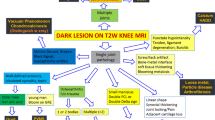Abstract
The aim of this study was to evaluate the use of MR imaging for diagnosis and therapy management of compartment syndromes. In total, 15 patients (5 with an imminent compartment syndrome and 10 with manifest compartment syndrome) underwent MR imaging with a variety of pulse sequences including fat suppression, magnetization transfer imaging, and intravenous gadopentetate dimeglumine (Gd-DTPA) administration. Early and late follow-up MR images were obtained. Manifest compartment syndromes showed swollen compartments with loss of normal muscle architecture on T1-weighted spin-echo images. T2-weighted spin-echo and magnetization transfer imaging showed bright areas, which enhanced after Gd-DTPA. Early follow-up showed changes in enhancement patterns; late follow-up showed fibrosis and cystic and fatty degenerations of the affected compartments. MR imaging can help make the diagnosis of a manifest compartment syndrome in clinically ambiguous cases. It points out the affected compartments and allows the surgeon to selectively split the fascial spaces.






Similar content being viewed by others
References
Matsen FA (1980) Compartmental syndromes. Grune and Stratton, New York
Hider SL, Hilton RC, Hutchinson C (2002) Chronic exertional compartment syndrome as a cause of bilateral forearm pain. Arthritis Rheum 46:2245–2246
Farmer KW, McFarland EG, Sonin A, Cosgarea AJ, Roehrig GJ (2002) Isolated necrosis of the brachialis muscle due to exercise. Orthopedics 25:682–684
Steinmann SP, Bishop AT (2000) Chronic anconeus compartment syndrome: a case report. J Hand Surg 25:959–961
Kitajima I, Tachibana S, Hirota Y, Nakamichi K (2002) Acute paraspinal muscle compartment syndrome treated with surgical decompression: a case report. Am J Sports Med 30:283–285
Takakuwa T, Takeda M, Tada H, Katsuki M, Nakamura S, Matsuno T (2000) Acute compartment syndrome of the supraspinatus: a case report. J Shoulder Elbow Surg 9:152–156
Rodenwaldt J, Dresing K, Grabbe E (1999) MR visualization in rhabdomyolysis with compartment syndrome of the pelvis and thigh. RÖFO 171:337–339
Echtermeyer V (1985) The compartment syndrome. Springer Verlag, Berlin Heidelberg New York
Scola E (1991) Pathophysiology and pressure monitoring in compartment syndromes. Unfallchirurg 94:220–224
Matsen FA, Winquist RA, Krugmire RB (1980) Diagnosis and management of compartmental syndromes. J Bone Joint Surg 62:286–291
Amendola A, Rorabeck CH, Vellett D, Vezina W, Rutt B, Nott L (1990). The use of magnetic resonance imaging in exertional compartment syndrome. Am J Sports Med 18:29–34
Lauder TD, Stuart MJ, Amrami KK, Felmlee JP (2002) Exertional compartment syndrome and the role of magnetic resonance imaging. Am J Phys Med Rehabil 81:315–319
Verleisdonk EJ, van Gils A, van der Werken C (2001) The diagnostic value of MRI scans for the diagnosis of chronic exertional compartment syndrome of the lower leg. Skeletal Radiol 30:321–325
Eskelin MK, Lotjonen JM, Mantysaari MJ (1998) Chronic exertional compartment syndrome: MR imaging at 0.1 T compared with tissue pressure measurement. Radiology 206:333–337
Mattila KT, Komu ME, Dahlstrom S, Koskinen SK, Heikkila J (1999) Medial tibial pain: a dynamic contrast-enhanced MRI study. Magn Reson Imaging 17:947–954
Yao L, Sinha U (2000) Imaging the microcirculatory proton fraction of muscle with diffusion-weighted echo-planar imaging. Acad Radiol 7:27–32
Wolff SD, Balaban RS (1994) Magnetization transfer imaging: practical aspects and clinical applications. Radiology 192:593–599
Duewell S, Hagspiel KD, Zuber J, von Schulthess GK, Bollinger A, Fuchs WA (1992) Swollen lower extremity: role of MR imaging. Radiology 184:227–231
Fleckenstein JL, Burns D, Murphy K, Jayson H, Bonte F (1991) Differential diagnosis of bacterial myositis in AIDS: MRI evaluation. Radiology 179:653–658
Sievers KW, Högerle S, Olivier LS, Küllmer K, Kisters U (1995) MR evaluation of the lower limb after compartment syndrome. Unfallchirurgie 21:64–69
Acknowledgment
I thank Johannes Heverhagen for helpful discussions and editing and review of the manuscript.
Author information
Authors and Affiliations
Corresponding author
Rights and permissions
About this article
Cite this article
Rominger, M.B., Lukosch, C.J. & Bachmann, G.F. MR imaging of compartment syndrome of the lower leg: a case control study. Eur Radiol 14, 1432–1439 (2004). https://doi.org/10.1007/s00330-004-2305-5
Received:
Revised:
Accepted:
Published:
Issue Date:
DOI: https://doi.org/10.1007/s00330-004-2305-5




